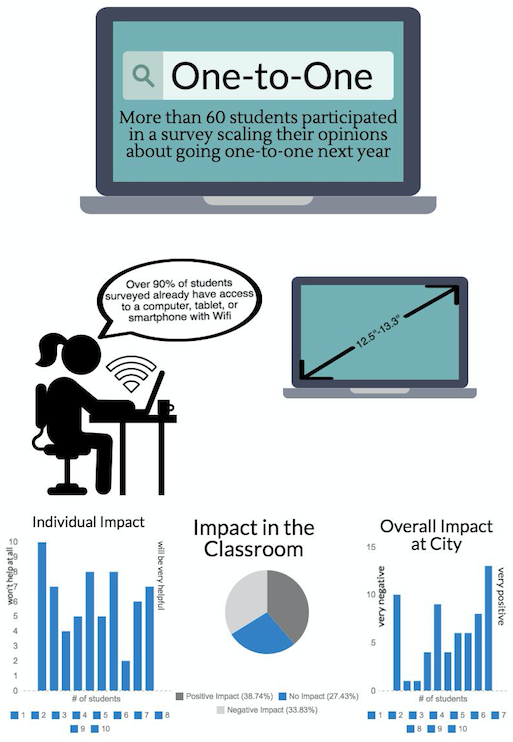One-to-One: One step forward or one step back?
December 16, 2016
Students are hunched over their Chromebooks in class, the occasional whisper breaking the constant rhythm of tapping. It’s the average day of work in English teacher Colleen Davis’s U.S. Lit Honors class. But next year there will be changes in the classroom–no more classroom cart of laptops and no more lining up in front of the cart. Instead, every high school student in the Iowa City Community School District will be receiving their own Chromebook.
Going One-to-One with Chromebooks will serve roughly 4,000 high school students total, and 2,000 more students when the program initiates in the junior high schools. 1:1 is a significant investment in the modernization of education in today’s technologically advanced society and will “provide an important resource that students can use both within and outside of school,” according to Adam Kurth, Director of Technology & Innovation for the ICCSD.
Many students don’t share the Kurth’s belief that 1:1 is a positive step. In a survey of 64 City High School students, 61% of students said that 1:1 would either not affect their classes at all or have a negative effect–possibly because over 90% of those students surveyed already have access to a computer, tablet, or smartphone, with wifi at home and usually study there too.
“I don’t see it making much of a difference at all. Most of my classes do not necessitate the use of a computer, and the ones that do have enough computers in the classroom for everyone to use.” said Quenton Max ‘18. “I see this a just another vain attempt to improve education by improving technology, even if that isn’t always the best solution.”
Davis uses Chromebooks almost every week in her classes, but believes that putting a Chromebook in every students’ hands could lessen the students’ attention spans.
“I don’t know how the logistics will work, but as someone who watches kids get completely distracted by technology, social media, phones–I’m a little concerned about when they have a computer in front of them all the time [and] how much they’re going to be able to control their desires to move off topic and onto something distracting.” said Davis.
Conversely, Serena Collins ‘18 believes that going 1:1 next year will definitely help shorten time wasted in school.
“We won’t have to waste class time lining up to get computers, waiting for everyone to get logged on, and then plugging them back in.” said Collins. “[and] students won’t have to waste time searching for a working computer in the library.”
Leveling the technological playing field for school work is also an important reason that Collins cites for her support for going One-to-One. Nearly 10% of students surveyed don’t have access to things like their school Google accounts at home. But 45% students with access to those accounts surveyed said that going One-to-One would help them.
“One-to-One would allow students to have all their resources with them and would allow us to maximize homework time,” said Collins.
But Max doesn’t believe going 1:1 is worth the price. Going 1:1 next year will initially cost $748,000 for the Chromebooks and a management license that will keep the laptops updated and download softwares as needed. This program will also retain a cost $293,000 per year to replace older Chromebooks.
“I don’t they will have enough benefit to necessitate spending large sums of money to give one to every student. In a way, this is very similar to putting a SmartBoard in every classroom.” Max explains. “I have one class that I feel is improved by having a SmartBoard, but other than that I don’t feel they are necessary.”
Another issue presented by both people in support and in opposition of the idea is the battery life.
“We have been assured that there will be backup chargers in classroom that we can use to charge, but when I look at the number of phones that I charge on a daily basis in my classroom-and those are sacred items to the students.” said Davis. “I’m not super confident that those Chromebooks are going to get charged on a regular basis.”
While Kurth suggests that the problems are inevitable, he thinks that the implementation of 1:1 will ultimately pay off.
“There will be substantial challenges–logistically, financially, and instructionally–that come with implementation of 1:1 in our secondary grades,” Kurth said, “But on the balance, I think that it’s a valuable tool that can substantially impact student learning and our educational environment.”
Although only 39% of students surveyed think that this move will show a positive effect on their classes, approximately 60% of those surveyed think that this is a step forward.
“Better student performance is always our goal as educators, as a building, and as a district. We want to see students perform better and increase their academic learning,” said Davis. “So hopefully, we will find ways to use the technology to do that.”































